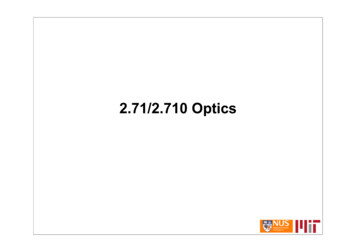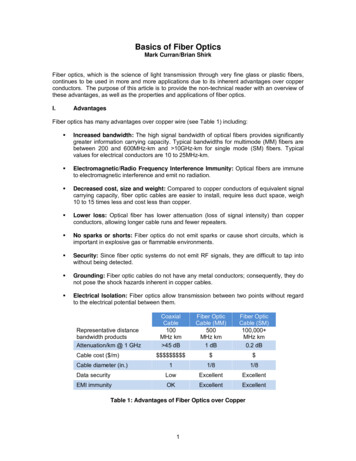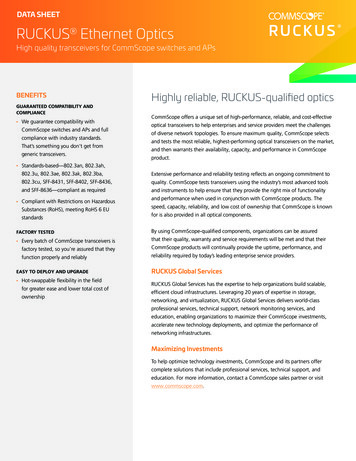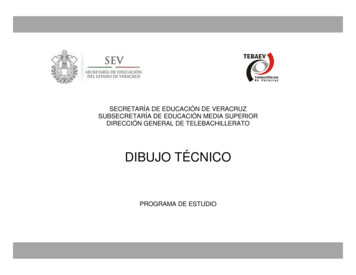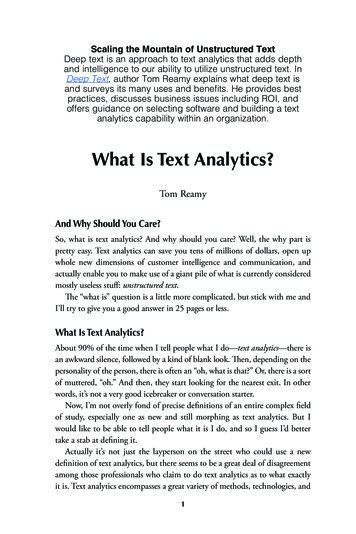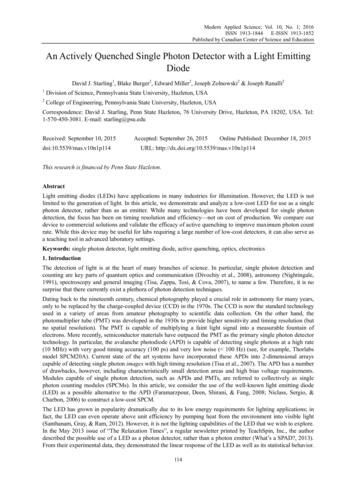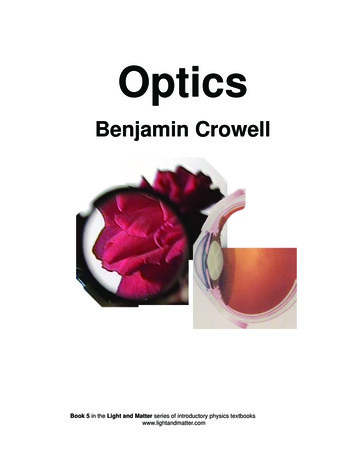
Transcription
OpticsBenjamin CrowellBook 5 in the Light and Matter series of introductory physics textbookswww.lightandmatter.com
Optics
The Light and Matter series ofintroductory physics textbooks:1Newtonian Physics2Conservation Laws3Vibrations and Waves4Electricity and Magnetism5Optics6The Modern Revolution in Physics
OpticsBenjamin Crowellwww.lightandmatter.com
Light and MatterFullerton, Californiawww.lightandmatter.com 1999 by Benjamin CrowellAll rights reserved.Edition 2.0rev. 2000-09-09ISBN 0-9704670-5-2
Brief Contents1 The Ray Model of Light .112 Images by Reflection, Part I . 253 Images by Reflection, Part II . 334 Refraction and Images . 435 Wave Optics . 57Exercises. 73Solutions to Selected Problems . 79Glossary . 81Index . 83Contents7
Contents1 The Ray Modelof Light111.1 The Nature of Light . 121.2 Interaction of Light with Matter . 151.3 The Ray Model of Light . 171.4 Geometry of Specular Reflection . 201.5* The Principle of Least Time for Reflection22Summary . 23Homework Problems . 243 Images by Reflection,Part II333.1 A Real Image Formed by an In-BendingMirror . 343.2 Other Cases With Curved Mirrors . 363.3* Aberrations . 40Summary . 41Homework Problems . 422 Images by Reflection,Part I252.1 A Virtual Image . 262.2 Curved Mirrors . 272.3 A Real Image . 282.4 Images of Images . 29Summary . 31Homework Problems . 328Contents
4Refractionand Images434.1 Refraction . 444.2 Lenses . 504.3* The Lensmaker’s Equation . 524.4* Refraction and the Principle of Least Time52Summary . 53Homework Problems . 545Wave OpticsExercises73Solutions to SelectedProblems79GlossaryIndexUseful Data818390575.1 Diffraction .5.2 Scaling of Diffraction .5.3 The Correspondence Principle .5.4 Huygens’ Principle .5.5 Double-Slit Diffraction .5.6 Repetition .5.7 Single-Slit Diffraction .Summary .Homework Problems .585960616266676970Contents9
10Contents
1The Ray Model of LightAds for the latest Macintosh computer brag that it can do an arithmeticcalculation in less time than it takes for the light to get from the screen toyour eye. We find this impressive because of the contrast between the speedof light and the speeds at which we interact with physical objects in ourenvironment. Perhaps it shouldn’t surprise us, then, that Newton succeededso well in explaining the motion of objects, but was far less successful withthe study of light.This textbook series is billed as the Light and Matter series, but onlynow, in the fifth of the six volumes, are we ready to focus on light. If youare reading the series in order, then you know that the climax of our studyof electricity and magnetism was discovery that light is an electromagneticwave. Knowing this, however, is not the same as knowing everything abouteyes and telescopes. In fact, the full description of light as a wave can berather cumbersome. We will instead spend most of this book making use ofa simpler model of light, the ray model, which does a fine job in mostpractical situations. Not only that, but we will even backtrack a little andstart with a discussion of basic ideas about light and vision that predated thediscovery of electromagnetic waves. Research in physics eduction has shownconclusively that the mere assertion that light is an electromagnetic wave iswoefully insufficient to allow a student to interpret ordinary phenomenainvolving light.11
1.1 The Nature of LightThe cause and effect relationship in visionDespite its title, this chapter is far from your first look at light. Thatfamiliarity might seem like an advantage, but most people have neverthought carefully about light and vision. Even smart people who havethought hard about vision have come up with incorrect ideas. The ancientGreeks, Arabs and Chinese had theories of light and vision, all of whichwere mostly wrong, and all of which were accepted for thousands of years.One thing the ancients did get right is that there is a distinctionbetween objects that emit light and objects that don’t. When you see a leafin the forest, it’s because three different objects are doing their jobs: the leaf,the eye, and the sun. But luminous objects like the sun, a flame, or thefilament of a light bulb can be seen by the eye without the presence of athird object. Emission of light is often, but not always, associated with heat.In modern times, we are familiar with a variety of objects that glow withoutbeing heated, including fluorescent lights and glow-in-the-dark toys.How do we see luminous objects? The Greek philosophers Pythagoras(b. ca. 560 BC) and Empedocles of Acragas (b. ca. 492 BC), who unfortunately were very influential, claimed that when you looked at a candleflame, the flame and your eye were both sending out some kind of mysterious stuff, and when your eye’s stuff collided with the candle’s stuff, thecandle would become evident to your sense of sight.Bizarre as the Greek “collision of stuff theory” might seem, it had acouple of good features. It explained why both the candle and your eye hadto be present for your sense of sight to function. The theory could alsoeasily be expanded to explain how we see nonluminous objects. If a leaf, forinstance, happened to be present at the site of the collision between youreye’s stuff and the candle’s stuff, then the leaf would be stimulated to expressits green nature, allowing you to perceive it as green.Modern people might feel uneasy about this theory, since it suggeststhat greenness exists only for our seeing convenience, implying a humanprecedence over natural phenomena. Nowadays, people would expect thecause and effect relationship in vision to be the other way around, with theleaf doing something to our eye rather than our eye doing something to theleaf. But how can you tell? The most common way of distinguishing causefrom effect is to determine which happened first, but the process of seeingseems to occur too quickly to determine the order in which things happened. Certainly there is no obvious time lag between the moment whenyou move your head and the moment when your reflection in the mirrormoves.Today, photography provides the simplest experimental evidence thatnothing has to be emitted from your eye and hit the leaf in order to make it“greenify.” A camera can take a picture of a leaf even if there are no eyesanywhere nearby. Since the leaf appears green regardless of whether it isbeing sensed by a camera, your eye, or an insect’s eye, it seems to makemore sense to say that the leaf ’s greenness is the cause, and somethinghappening in the camera or eye is the effect.12Chapter 1 The Ray Model of Light
Light is a thing, and it travels from one point to another.Another issue that few people have considered is whether a candle’sflame simply affects your eye directly, or whether it sends out light whichthen gets into your eye. Again, the rapidity of the effect makes it difficult totell what’s happening. If someone throws a rock at you, you can see the rockon its way to your body, and you can tell that the person affected you bysending a material substance your way, rather than just harming youdirectly with an arm motion, which would be known as “action at a distance.” It is not easy to do a similar observation to see whether there is some“stuff ” that travels from the candle to your eye, or whether it is a case ofaction at a distance.Newtonian physics includes both action at a distance (e.g. the earth’sgravitational force on a falling object) and contact forces such as the normalforce, which only allow distant objects to exert forces on each other byshooting some substance across the space between them (e.g. a garden hosespraying out water that exerts a force on a bush).glassLight from a candle is bumped offcourse by a piece of glass. Insertingthe glass causes the apparent location of the candle to shift. The sameeffect can be produced by taking offyour eyeglasses and looking at whatyou see in the lens, but a flat piece ofglass works just as well as a lens forthis purpose.One piece of evidence that the candle sends out stuff that travels toyour eye is that intervening transparent substances can make the candleappear to be in the wrong location, suggesting that light is a thing that canbe bumped off course. Many people would dismiss this kind of observationas an optical illusion, however. (Some optical illusions are purely neurological or psychological effects, although some others, including this one, turnout to be caused by the behavior of light itself.)A more convincing way to decide in which category light belongs is tofind out if it takes time to get from the candle to your eye; in Newtonianphysics, action at a distance is supposed to be instantaneous. The fact thatwe speak casually today of “the speed of light” implies that at some point inhistory, somebody succeeded in showing that light did not travel infinitelyfast. Galileo tried, and failed, to detect a finite speed for light, by arrangingwith a person in a distant tower to signal back and forth with lanterns.Galileo uncovered his lantern, and when the other person saw the light, heuncovered his lantern. Galileo was unable to measure any time lag that wassignificant compared to the limitations of human reflexes.Section 1.1The Nature of Light13
JupitersunearthIoThe first person to prove that light’s speed was finite, and to determineit numerically, was Ole Roemer, in a series of measurements around the year1675. Roemer observed Io, one of Jupiter’s moons, over a period of severalyears. Since Io presumably took the same amount of time to complete eachorbit of Jupiter, it could be thought of as a very distant, very accurate clock.A practical and accurate pendulum clock had recently been invented, soRoemer could check whether the ratio of the two clocks’ cycles, about 42.5hours to 1 orbit, stayed exactly constant or changed a little. If the process ofseeing the distant moon was instantaneous, there would be no reason forthe two to get out of step. Even if the speed of light was finite, you mightexpect that the result would be only to offset one cycle relative to the other.The earth does not, however, stay at a constant distance from Jupiter and itsmoons. Since the distance is changing gradually due to the two planets’orbit motions, a finite speed of light would make the “Io clock” appear torun faster as the planets drew near each other, and more slowly as theirseparation increased. Roemer did find a variation in the apparent speed ofIo’s orbits, which caused Io’s eclipses by Jupiter (the moments when Iopassed in front of or behind Jupiter) to occur about 7 minutes early whenthe earth was closest to Jupiter, and 7 minutes late when it was farthest.Based on these measurements, Roemer estimated the speed of light to beapproximately 2x108 m/s, which is in the right ballpark compared tomodern measurements of 3x108 m/s. (I’m not sure whether the fairly largeexperimental error was mainly due to imprecise knowledge of the radius ofthe earth’s orbit or limitations in the reliability of pendulum clocks.)Light can travel through a vacuum.Many people are confused by the relationship between sound and light.Although we use different organs to sense them, there are some similarities.For instance, both light and sound are typically emitted in all directions bytheir sources. Musicians even use visual metaphors like “tone color,” or “abright timbre” to describe sound. One way to see that they are clearlydifferent phenomena is to note their very different velocities. Sure, both arepretty fast compared to a flying arrow or a galloping horse, but as we haveseen, the speed of light is so great as to appear instantaneous in mostsituations. The speed of sound, however, can easily be observed just bywatching a group of schoolchildren a hundred feet away as they clap theirhands to a song. There is an obvious delay between when you see theirpalms come together and when you hear the clap.The fundamental distinction between sound and light is that sound isan oscillation in air pressure, so it requires air (or some other medium suchas water) in which to travel. Today, we know that outer space is a vacuum,so the fact that we get light from the sun, moon and stars clearly shows thatair is not necessary for the propagation of light. Also, a light bulb has a nearvacuum inside, but that does not prevent the light from getting out. (Thereason why the air is pumped out of light bulbs is to keep the oxygen fromreacting violently with the hot filament and destroying it.)Discussion QuestionsA. If you observe thunder and lightning, you can tell how far away the storm is.Do you need to know the speed of sound, of light, or of both?B. When phenomena like X-rays and cosmic rays were first discovered,suggest a way one could have tested whether they were forms of light.C. Why did Roemer only need to know the radius of the earth’s orbit, notJupiter’s, in order to find the speed of light?14Chapter 1 The Ray Model of Light
1.2Interaction of Light with MatterAbsorption of lightThe reason why the sun feels warm on your skin is that the sunlight isbeing absorbed, and the light energy is being transformed into heat energy.The same happens with artificial light, so the net result of leaving a lightturned on is to heat the room. It doesn’t matter whether the source of thelight is hot, like the sun, a flame, or an incandescent light bulb, or cool, likea fluorescent bulb. (If your house has electric heat, then there is absolutelyno point in fastidiously turning off lights in the winter; the lights will helpto heat the house at the same dollar rate as the electric heater.)This process of heating by absorption is entirely different from heatingby thermal conduction, as when an electric stove heats spaghetti saucethrough a pan. Heat can only be conducted through matter, but there isvacuum between us and the sun, or between us and the filament of anincandescent bulb. Also, heat conduction can only transfer heat energyfrom a hotter object to a colder one, but a cool fluorescent bulb is perfectlycapable of heating something that had already started out being warmerthan the bulb itself.How we see nonluminous objectsNot all the light energy that hits an object is transformed into heat.Some is reflected, and this leads us to the question of how we seenonluminous objects. If you ask the average person how we see a light bulb,the most likely answer is “The light bulb makes light, which hits our eyes.”But if you ask how we see a book, they are likely to say “The bulb lights upthe room, and that lets me see the book.” All mention of light actuallyentering our eyes has mysteriously disappeared.Most people would disagree if you told them that light was reflectedfrom the book to the eye, because they think of reflection as something thatmirrors do, not something that a book does. They associate reflection withthe formation of a reflected image, which does not seem to appear in a pieceof paper.specular reflectiondiffuse reflection(a) Diffuse and specular reflection.Imagine that you are looking at your reflection in a nice smooth pieceof aluminum foil, fresh off the roll. You perceive a face, not a piece of metal.Perhaps you also see the bright reflection of a lamp over your shoulderbehind you. Now imagine that the foil is just a little bit less smooth. Thedifferent parts of the image are now a little bit out of alignment with eachother. Your brain can still recognize a face and a lamp, but it’s a littlescrambled, like a Picasso painting. Now suppose you use a piece of aluminum foil that has been crumpled up and then flattened out again. The partsof the image are so scrambled that you cannot recognize an image. Instead,your brain tells you you’re looking at a rough, silvery surface.Mirrorlike reflection at a specific angle is known as specular reflection,and random reflection in many directions is called diffuse reflection.Diffuse reflection is how we see nonluminous objects. Specular reflectiononly allows us to see images of objects other than the one doing the reflecting. In top part of figure (a), imagine that the rays of light are coming fromthe sun. If you are looking down at the reflecting surface, there is no wayfor your eye-brain system to tell that the rays are not really coming from asun down below you.Section 1.2Interaction of Light with Matter15
Figure (b) shows another example of how we can’t avoid the conclusionthat light bounces off of things other than mirrors. The lamp is one I havein my house. It has a bright bulb, housed in a completely opaque bowlshaped metal shade. The only way light can get out of the lamp is by goingup out of the top of the bowl. The fact that I can read a book in theposition shown in the figure means that light must be bouncing off of theceiling, then bouncing off of the book, then finally getting to my eye.This is where the shortcomings of the Greek theory of vision becomeglaringly obvious. In the Greek theory, the light from the bulb and mymysterious “eye rays” are both supposed to go to the book, where theycollide, allowing me to see the book. But we now have a total of fourobjects: lamp, eye, book, and ceiling. Where does the ceiling come in? Doesit also send out its own mysterious “ceiling rays,” contributing to a threeway collision at the book? That would just be too bizarre to believe!(b)The differences among white, black, and the various shades of grey inbetween is a matter of how what percentage of the light they absorb andwhat percentage they reflect. That’s why light-colored clothing is morecomfortable in the summer, and light-colored upholstery in a car stayscooler that dark upholstery.Numerical measurement of the brightness of lightWe have already seen that the physiological sensation of loudness relatesto the sound’s intensity (power per unit area), but is not directly proportional to it. If sound A has an intensity of 1 nW/m2, sound B is 10 nW/m2,and sound C is 100 nW/m2, then the increase in loudness from C to B isperceived to be the same as the increase from A to B, not ten times greater.That is, the sensation of loudness if logarithmic.The same is true for the brightness of light. Brightness is related topower per unit area, but the relationship is a logarithmic one rather than aproportionality. For doing physics, it’s the power per unit area that we’reinterested in. The relevant SI unit is W/m2, although various non-SI unitsare still used in photography, for example. One way to determine thebrightness of light is to measure the increase in temperature of a blackobject exposed to the light. The light energy is being converted to heatenergy, and the amount of heat energy absorbed in a given amount of timecan be related to the power absorbed, using the known heat capacity of theobject. More practical devices for measuring light intensity, such as the lightmeters built into some cameras, are based on the conversion of light intoelectrical energy, but these meters have to be calibrated somehow againstheat measurements.Discussion questionswintersummerDiscussion question C.16A. The curtains in a room are drawn, but a small gap lets light through,illuminating a spot on the floor. It may or may not also be possible to see thebeam of sunshine crossing the room, depending on the conditions. What’sgoing on?B. Laser beams are made of light. In science fiction movies, laser beams areoften shown as bright lines shooting out of a laser gun on a spaceship. Why isthis scientifically incorrect?C. A documentary filmmaker went to Harvard’s 1987 graduation ceremony andasked the graduates, on camera, to explain the cause of the seasons. Onlytwo out of 23 were able to give a correct explanation, but you now have all theinformation needed to figure it out for yourself, assuming you didn’t alreadyknow. The figure shows the earth in its winter and summer positions relative toChapter 1 The Ray Model of Light
the sun. Hint: Consider the units used to measure the brightness of light, andrecall that the sun is lower in the sky in winter, so its rays are coming in at ashallower angle.1.3The Ray Model of LightModels of lightNote how I’ve been casually diagramming the motion of light withpictures showing light rays as lines on the page. More formally, this isknown as the ray model of light. The ray model of light seems natural oncewe convince ourselves that light travels through space, and observe phenomena like sunbeams coming through holes in clouds. Having alreadybeen introduced to the concept of light as an electromagnetic wave, youknow that the ray model is not the ultimate truth about light, but the raymodel is simpler, and in any case science always deals with models of reality,not the ultimate nature of reality. The following table summarizes threemodels of light.ray modelAdvantage: Simplicity.Advantage: Color is describednaturally in terms of wavelength.Required in order to explain theinteraction of light with materialobjects with sizes comparable toa wavelength of light or smaller.wave modelRequired in order to explain theinteraction of light with individualatoms. At the atomic level, itbecomes apparent that a beam oflight has a certain graininess to it.particle modelThe ray model is essentially a generic one. By using it we can discuss thepath taken by the light, without committing ourselves to any specificdescription of what it is that is moving along that path. We will use the nicesimple ray model for most of this book, and with it we can analyze a greatmany devices and phenomena. Not until the last chapter will we concernourselves specifically with wave optics, although in the intervening chaptersI will sometimes analyze the same phenomenon using both the ray modeland the wave model.Note that the statements about the applicability of the various modelsare only rough guides. For instance, wave interference effects are oftendetectable, if small, when light passes around an obstacle that is quite a bitSection 1.3The Ray Model of Light17
bigger than a wavelength. Also, the criterion for when we need the particlemodel really has more to do with energy scales than distance scales, although the two turn out to be related.The alert reader may have noticed that the wave model is required atscales smaller than a wavelength of light (on the order of a micrometer forvisible light), and the particle model is demanded on the atomic scale orlower (a typical atom being a nanometer or so in size). This implies that atthe smallest scales we need both the wave model and the particle model.They appear incompatible, so how can we simultaneously use both? Theanswer is that they are not as incompatible as they seem. Light is both awave and a particle, but a full understanding of this apparently nonsensicalstatement is a topic for the following book in this series.Ray diagramsWithout even knowing how to use the ray model to calculate anythingnumerically, we can learn a great deal by drawing ray diagrams. For instance, if you want to understand how eyeglasses help you to see in focus, aray diagram is the right place to start. Many students underutilize raydiagrams in optics and instead rely on rote memorization or plugging intoformulas. The trouble with memorization and plug-ins is that they canobscure what’s really going on, and it is easy to get them wrong. Often thebest plan is to do a ray diagram first, then do a numerical calculation, thencheck that your numerical results are in reasonable agreement with whatyou expected from the ray diagram.Examples (a) through (c) show some guidelines for using ray diagramseffectively. The light rays bend when then pass out through the surface ofthe water (a phenomenon that we’ll discuss in more detail later). The raysappear to have come from a point above the goldfish’s actual location, anExamples of ray diagrams.18Chapter 1 The Ray Model of Light
effect that is familiar to people who have tried spearfishing. A stream of light is not really confined to a finite number of narrowlines. We just draw it that way. In (a), it has been necessary to choosea finite number of rays to draw (five), rather than the theoreticallyinfinite number of rays that will diverge from that point. There is a tendency to conceptualize rays incorrectly as objects. In hisOptics, Newton goes out of his way to caution the reader against this,saying that some people “consider . the refraction of . rays to be thebending or breaking of them in their passing out of one medium intoanother.” But a ray is a record of the path traveled by light, not aphysical thing that can be bent or broken.(a) correct In theory, rays may continue infinitely far into the past and future, butwe need to draw lines of finite length. In (a), a judicious choice hasbeen made as to where to begin and end the rays. There is no point incontinuing the rays any farther than shown, because nothing newand exciting is going to happen to them. There is also no good reasonto start them earlier, before being reflected by the fish, because thedirection of the diffusely reflected rays is random anyway, and unrelated to the direction of the original, incoming ray.(b) Incorrect: implies that diffuse reflection only gives oneray from each reflecting point.(c) Correct, but unnecessarilycomplicated. When representing diffuse reflection in a ray diagram, many studentshave a mental block against drawing many rays fanning out from thesame point. Often, as in example (b), the problem is the misconception that light can only be reflected in one direction from one point. Another difficulty associated with diffuse reflection, example (c), is thetendency to think that in addition to drawing many rays coming outof one point, we should also be drawing many rays coming from manypoints. In (a), drawing many rays coming out of one point gives useful information, telling us, for instance, that the fish can be seen fromany angle. Drawing many sets of rays, as in (c), does not give us anymore useful information, and just clutters up the picture in this example. The only reason to draw sets of rays fanning out from morethan one point would be if different things were happening to thedifferent sets.Discussion QuestionSuppose an intelligent tool-using fish is spearhunting for humans. Draw a raydiagram to show how the fish has to correct its aim. Note that although therays are now passing from the air to the water, the same rules apply: the raysare closer to being perpendicular to the surface when they are in the water,and rays that hit the air-water interface at a shallow angle are bent the most.Section 1.3The Ray Model of Light19
1.4 Geometry of Specular ReflectionTo change the motion of a material object, we use a force. Is there anyway to exert a force on a beam of light? Experiments show that electric andmagnetic fields do not deflect light beams, so apparently light has noelectric charge. Light also has no mass, so until the twentieth century it wasbelieved to be immune to gravity as well. Einstein predicted that lightbeams would be very slightly deflected by strong gravitational fields, and hewas proven correct by observations of rays of starlight that came close to thesun, but obviously that’s not what makes mirrors and lenses work!If we investigate how light is reflected by a mirror, we will find that theprocess is horrifically complex, but the final result is surprisingly simple.What actually happens is that the light is made of electric and magneticfields, and these fields accelerate the electrons in the mirror. Energy fromthe light beam is momentarily transformed into extra kinetic energy of theelectrons, but because the electrons are accelerating the reradiate more light,converting their kinetic energy back into light energy. We might expect thisto result in a very chaotic situation, but amazingly enough, the electronsmove together to produce a new, reflected beam of light, which obeys twosimple rules:normalincidentrayreflectedrayBACD interfacebetweenthe two mediaplane ofincidence The angle of the reflected ray is the same as that of the incident ray. The reflected ray lies in the plane containing the incident ray and thenormal (perpendicular) line. This plane is known as the plane of incidence.The two angles can be defined either with respect to the normal, likeangles B and C in the figure, or with respect to the reflecting surface, likeangles A and D. There is a convention of several hundred years’ standingthat one measures the angles with respect to the normal, but the rule aboutequal angles can logically be stated either as B C or as A D.The phenomenon of reflection occurs only at the boundary betweentwo media, just like the change in the speed of light that passes fr
the study of light. This textbook series is billed as the Light and Matter series, but only now, in the fifth of the six volumes, are we ready to focus on light. If you are reading the series in order, then you know that the climax of our study of electricity and magnetism was discover
